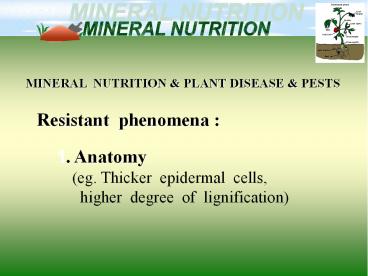MINERAL NUTRITION - PowerPoint PPT Presentation
1 / 10
Title: MINERAL NUTRITION
1
MINERAL NUTRITION PLANT DISEASE PESTS
Resistant phenomena
1. Anatomy (eg. Thicker epidermal cells,
higher degree of lignification)
2
2. Physiology Biochemistry
(Production of repelling substance
synthesis of toxins phytoalexins)
3. Escape from attack
(not synchronize development)
3
General role of nutrient
Balanced nutrient supply which ensures
optimal plant growth is also considered
optimal for plant resistance.
4
1. Fungal disease
1.1 Principle of infection
- Plant exudate promote spore germination on
leaf root (air - soil borne) - Exudate depend on cellular
- concentration membrane permeability
5
- Sugar amino acid K deficient
- Amino acid amide N excessive
- Phenol accumulation N, B Cu deff.
- Ca2 inhibit function of proteolytic
- enzyme from fungi to dissolve middle
- lamella
- Si increase lignification of epidermal
cell - layer
- N K effect depend on type of parasite
6
Ca
1) increase stability of membrane
Ca efflux of sugar from cytoplasm
apoplasm
more severe infection
2) Ca - pectate middle lamella stability
inhibit proteolytic enzyme of fungi
7
2. Bacteria Viral disease
Leaf spot diseases
Bacteria
Soft rots
Vascular diseases
Leaf spot diseases infect through stomata
multiply in the intercellular space
K Ca deficient enhance infection
8
Soft rots infect through wounds and produce
proteolytic enzyme
- Wound cork formation inhibit
- infection increase formation when
- K sufficient
- B deficient causes cracking
- Ca inhibit proteolytic enzyme
9
Vascular disease plug vessel of xylem then
causes wilt bacterial wilt
Viral diseases
- need amino acid nucleotides
- excessive N, P K reduce severity of
- N deficient in plant due to nutrient
- competition
between virus plant cells
10
3. Soilborne Fungal Bacterial Diseases
Protection
- Chemical barriers (Polyphenol)
- Physical barriers (Sillicon in endodermis)
- pH adjustment and fungal growth
- Mn, Ca application
- NH4 NO3 - base fertilizer pH
- Ammonia toxic to Fusarium
- Nitrite (NO2) toxic to Pythium
- Phytophthora
The End































